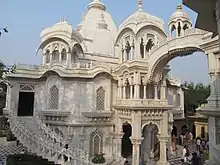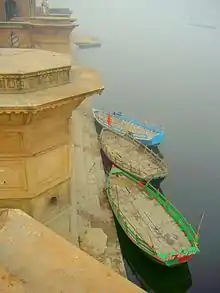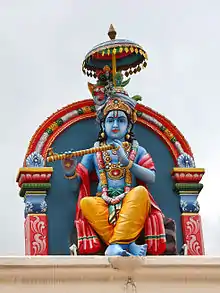Vrindavan
Vrindavan (![]() pronunciation ; IAST: Vṛndāvana), also spelt Vrindaban and Brindaban,[2] is a historical city in the Mathura district of Uttar Pradesh, India. It is one of the most sacred places in Vaishnavism.[3] It is located in the Braj Bhoomi region, and is where, according to Hinduism, Lord Krishna spent most of his childhood days.[4] The city is about 11 km from Mathura, Krishna's birthplace on the Agra-Delhi National Highway as NH-44.[5][6] The town hosts many temples dedicated to the worship of Radha and Krishna.[3]
pronunciation ; IAST: Vṛndāvana), also spelt Vrindaban and Brindaban,[2] is a historical city in the Mathura district of Uttar Pradesh, India. It is one of the most sacred places in Vaishnavism.[3] It is located in the Braj Bhoomi region, and is where, according to Hinduism, Lord Krishna spent most of his childhood days.[4] The city is about 11 km from Mathura, Krishna's birthplace on the Agra-Delhi National Highway as NH-44.[5][6] The town hosts many temples dedicated to the worship of Radha and Krishna.[3]
Vrindavan
Vrindaban, Brindaban | |
|---|---|
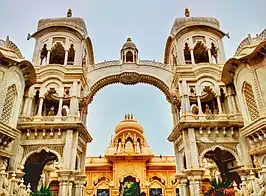 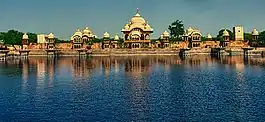 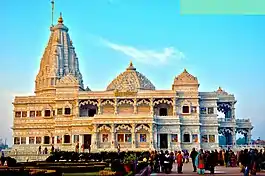 Top to bottom: Krishna Balaram Mandir, Kusum Sarovar, and Prem Mandir (Love temple) in Vrindavan | |
| Nicknames: City of Widows | |
 Vrindavan Location in Uttar Pradesh, India  Vrindavan Vrindavan (India) | |
| Coordinates: 27.58°N 77.7°E | |
| Country | |
| State | Uttar Pradesh |
| District | Mathura |
| Government | |
| • Type | Municipal Council |
| • Body | Vrindavan Municipal Council |
| Elevation | 170 m (560 ft) |
| Population (2011)[1] | |
| • Total | 63,005 |
| Demonym(s) | Vrindavan wasi |
| Languages | |
| • Official | Hindi |
| • Native | Braj Bhasha dialect |
| Time zone | UTC+05:30 (IST) |
| PIN | 281121 |
| Telephone code | 0565 |
| Vehicle registration | UP-85 |
Etymology
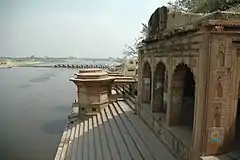
The ancient Sanskrit name of the city, वृन्दावन (Vṛndāvana), comes from its groves of vṛndā (Holy basil) and vana (a grove or forest).[2]
Geography
Vrindavan is located at 27.58°N 77.7°E.[7] It has an average elevation of 170 metres (557 feet).
Demographics
As of 2011 Indian Census, Vrindavan had a total population of 63,005, of which 34,769 were males and 28,236 were females. Population within the age group of 0 to 6 years was 7,818. The total number of literates in Vrindavan was 42,917, which constituted 68.11% of the population with male literacy of 73.7% and female literacy of 61.2%. The effective literacy rate of 7+ population of Vrindavan was 77.8%, of which male literacy rate was 83.7% and female literacy rate was 70.3%. The sex ratio is 812 females per 1000 males. The Scheduled Castes and Scheduled Tribes population was 6,294 and 18, respectively. Vrindavan had 11,637 households in 2011.[1][8]
Religious heritage
.jpg.webp)
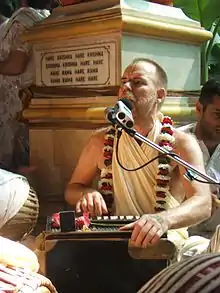
Vrindavan is considered to be a holy place for Vaisnavism tradition of Hinduism. It is a center of Krishna worship and the area includes places like Govardhana and Gokul that are associated with Krishna. Millions of devotees of Radha Krishna visit these places of pilgrimage every year and participate in a number of festivals.[9]
History
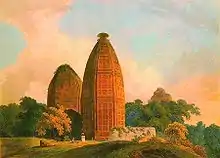
Vrindavan has an ancient past, associated with Hindu culture and history, and was established in the 16th and 17th centuries as a result of an explicit treaty between Muslims and Hindu Emperors,[10] and is an important Hindu pilgrimage site since long.
Of the contemporary times, Vallabhacharya, aged eleven visited Vrindavan. Later on, he performed three pilgrimages of India, barefoot giving discourses on Bhagavad Gita at 84 places. These 84 places are known as Pushtimarg Baithak and since then are the places of pilgrimage. Yet, he stayed in Vrindavan for four months each year. Vrindavan thus heavily influenced his formation of Pushtimarg.
The essence of Vrindavan was lost over time until the 16th century, when it was rediscovered by Chaitanya Mahaprabhu. In the year 1515, Chaitanya Mahaprabhu visited Vrindavana, with the purpose of locating the lost holy places associated with Krishna's life.[11]
In the last 250 years, the extensive forests of Vrindavan have been subjected to urbanisation, first by local Rajas and in recent decades by apartment developers. The forest cover has been whittled away to only a few remaining spots, and the local wildlife, including peacocks, cows, monkeys and a variety of bird species has been virtually eliminated. Only a few peacocks are left in the city but monkeys and cows can be seen almost everywhere.
Temples

Vrindavan, the land of Radharani and the city of temples, has more than 1000 temples to showcase the pastimes of Radha and Krishna.[12] Some of the important pilgrim sites are
- Madan Mohan Temple, located near the Kalidah Ghat was built by Kapur Ram Das of Multan. One of the oldest temples in Vrindavan, it is closely associated with the Lord Chaitanya Mahaprabhu. The original deity of Lord Madan Gopal was shifted from the shrine to Karauli in Rajasthan for safekeeping during Aurangzeb's rule. Today, a replica of the original (deity) is worshipped at the temple
- Sri Radha Raman Mandir, constructed at the request of Gopala Bhatta Goswami and houses a saligram deity of Krishna as Radha Ramana, alongside Radha.[13]
- Banke Bihari Temple, built in 1862[14] after the image of Banke-Bihari was discovered in Nidhi Vana by Swami Haridas.
- Prem Mandir is a spiritual complex situated on a 54-acre site on the outskirts of Vrindavan dedicated to divine love. The temple structure was established by spiritual guru Kripalu Maharaj.[15] The main structure built in marble and figures of Krishna cover the main temple.[16]
- Sri Krishna-Balarama Temple was built by the International Society for Krishna Consciousness (ISKCON) in Raman-Reti.[17] The principal deities of this temple are Krishna and Balaram, with Radha–Shyamasundar and Gaura-Nitai alongside. Adjoining the temple is the samadhi of A. C. Bhaktivedanta Swami Prabhupada, the founder of ISKCON, built in pure white marble.
- Vrindavan Chandrodaya Mandir is housed in a modern geodesic structure with a traditional gopuram based on Khajuraho style of architecture. It is being built by one of the ISKCON factions based in Bangalore.[18] At cost of ₹300 crore (US$42 million) it will be the tallest temple in world on completion.
City of Widows
Vrindavan is also known as the "city of widows"[19][20][21] due to the large number of widows who move into the town and surrounding area after losing their husbands. There are an estimated 15,000 to 20,000 widows. The widows come from states of west Bengal, Assam and Odisha.[22][23] Many spend time singing bhajan hymns at bhajanashrams. An organisation called Guild of Service was formed to assist these deprived women and children.[19][23] According to a survey report prepared by the government, several homes run by the government and different NGOs for widows.[24]
Transportation
Road
Vrindavan is well connected by roads and is connected to Delhi by National Highway (NH) 44 of the Golden Quadrilateral network. Earlier it was NH 2.[5]
Rail
- BDB/Vrindavan is on the Mathura-Vrindavan MG link.
- VRBD/Vrindaban Road is on the Agra-Delhi chord.
See also
References
- "Census of India: Vrindavan". www.censusindia.gov.in. Retrieved 9 October 2019.
- "Brindaban". The Imperial Gazetteer of India. 1909.
- Gopal, Madan (1990). K.S. Gautam (ed.). India through the ages. Publication Division, Ministry of Information and Broadcasting, Government of India. p. 176.
- "UP gets first officially designated 'teerth sthals' in Vrindavan and Barsana". Times of India. 27 October 2017.
- "NHAI". Retrieved 14 February 2018.
- Keene, Henry George (1899). "Bindrabun". A Handbook for Visitors to Agra and Its Neighbourhood. Thacker, Spink & Co. pp. 98–106.
- "Maps, Weather, and Airports for Vrindavan, India". www.fallingrain.com. Retrieved 6 December 2019.
- Jayant Pandurang Nayaka, Syed Nurullah (1974). A students' history of education in India (1800–1973) (6 ed.). Macmillan.CS1 maint: uses authors parameter (link)
- Klaus Klostermaier (2007). A Survey of Hinduism. State University of New York Press; 3 edition. p. 204. ISBN 978-0-7914-7081-7.
The center of Krishna-worship has been for a long time Brajbhumi, the district of Mathura that embraces also Vrindavana, Govardhana, and Gokula, associated with Krishna from the time immemorial. Many millions of Krishna bhaktas visit these places every year and participate in the numerous festivals that re-enact divine scenes from Krishna's life on Earth, of which were spent in those very places
Vrinda means Tulsi (A sacred species of flora) and van as forest, therefore Vrindavan is a holy forest of Tulsi. Vijaypal Baghel, known as GreenMan is promoting, planting and farming Tulsi in mass around the Vrindavan. - "Watch | John Stratton Hawley on His Latest Book on 'Krishna's Playground'". The Wire. 25 January 2020. Retrieved 3 March 2020.
- "Discovery of Vrindavan by Chaitanya Mahaprabhu". Retrieved 6 December 2019.
- http://news.vrindavantoday.org/2016/06/seven-main-temples-of-vrindavan
- "Sri Radha Raman in Vrindavan". www.salagram.net. Retrieved 6 December 2019.
- "Banke-Bihari Temple website". Retrieved 6 December 2019.
- "Famous Krishna Temples in India". Zee News. 20 August 2013. Retrieved 6 December 2019.
- Kumar, Mayank (13 February 2012). "Kripaluji Maharaj's Prem Mandir will be inaugurated on 17 February". Aaj Ki Khabar. Archived from the original on 30 March 2014. Retrieved 29 March 2014.
- "ISKCON Vrindavan - Home".
- "News18.com: CNN-News18 Breaking News India, Latest News Headlines, Live News Updates". News18. Retrieved 6 December 2019.
- "India's widows live out sentence of shame, poverty". Archived from the original on 29 November 2006. Retrieved 25 March 2007.
- "The Indian town with 6,000 widows". BBC News. 2 May 2013. Retrieved 12 January 2021.
- "The widows of Vrindavan". cnbctv18.com. 8 March 2019. Retrieved 12 January 2021.
- "Catalyst Magazine: Moksha: the widows of Vrindavan". Retrieved 25 March 2007.
- "Shunned from society, widows flock to city to die". CNN. 5 July 2007. Retrieved 5 July 2007.
- "Sulabh dons mantle". Retrieved 6 December 2019.
External links
- Vrindavan at the Encyclopædia Britannica
| Wikiquote has quotations related to: Vrindavan |
| Wikimedia Commons has media related to Vrindavan. |
![]() Vrindavan travel guide from Wikivoyage
Vrindavan travel guide from Wikivoyage
